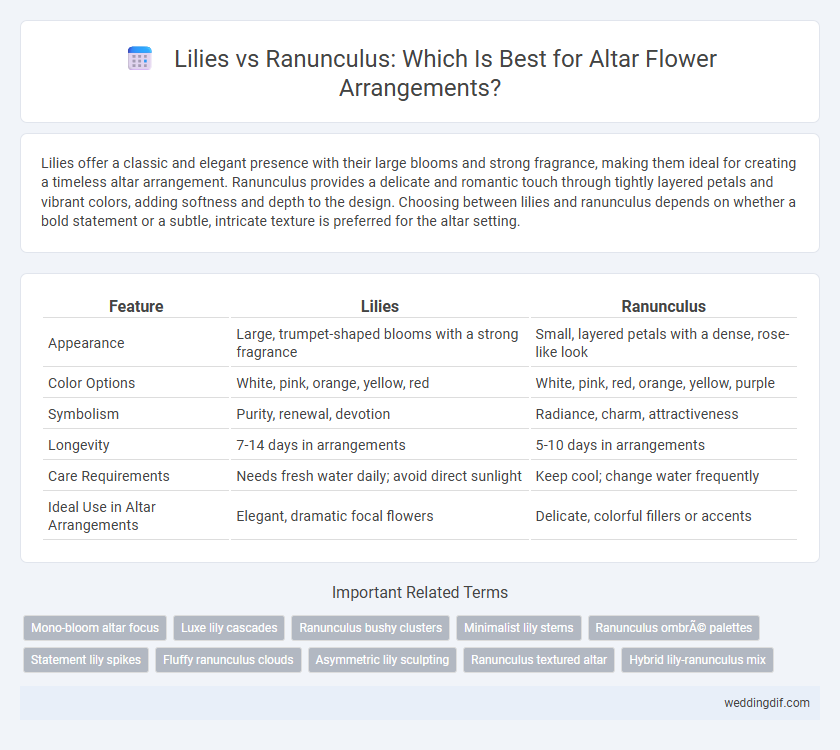Lilies offer a classic and elegant presence with their large blooms and strong fragrance, making them ideal for creating a timeless altar arrangement. Ranunculus provides a delicate and romantic touch through tightly layered petals and vibrant colors, adding softness and depth to the design. Choosing between lilies and ranunculus depends on whether a bold statement or a subtle, intricate texture is preferred for the altar setting.
Table of Comparison
| Feature | Lilies | Ranunculus |
|---|---|---|
| Appearance | Large, trumpet-shaped blooms with a strong fragrance | Small, layered petals with a dense, rose-like look |
| Color Options | White, pink, orange, yellow, red | White, pink, red, orange, yellow, purple |
| Symbolism | Purity, renewal, devotion | Radiance, charm, attractiveness |
| Longevity | 7-14 days in arrangements | 5-10 days in arrangements |
| Care Requirements | Needs fresh water daily; avoid direct sunlight | Keep cool; change water frequently |
| Ideal Use in Altar Arrangements | Elegant, dramatic focal flowers | Delicate, colorful fillers or accents |
Introduction to Lilies and Ranunculus for Altar Arrangements
Lilies and ranunculus are popular choices for altar arrangements due to their symbolic meanings and visual impact. Lilies, often representing purity and renewal, feature large, trumpet-shaped blooms that create a dramatic and elegant focal point. Ranunculus offers a softer, romantic appeal with densely layered petals and vibrant colors, adding texture and depth to sacred floral displays.
Visual Appeal: Comparing Lilies and Ranunculus
Lilies exhibit large, sculptural blooms with elegant trumpet shapes and a range of colors from white to deep orange, creating a striking focal point in altar arrangements. Ranunculus features densely layered petals resembling delicate roses, offering a soft, romantic texture and vibrant hues like pink, yellow, and red that add depth and warmth. Visually, lilies provide bold structure and height, while ranunculus contributes intricate detail and fullness, making both flowers complementary choices for diverse altar designs.
Symbolism and Meaning in Wedding Traditions
Lilies symbolize purity, commitment, and refined beauty, making them a classic choice for wedding altar arrangements that emphasize sacredness and devotion. Ranunculus represents charm, attractiveness, and radiant charm, adding a joyful and romantic touch to weddings focused on love's vibrancy. Both flowers convey deep emotional significance, but lilies are favored for solemnity while ranunculus enhances warmth and celebration.
Color Variety and Customization Options
Lilies offer a striking color palette that includes white, pink, orange, and yellow, allowing for versatile altar arrangements that can convey purity or warmth. Ranunculus blooms present an even broader spectrum with shades ranging from deep reds and purples to pastel pinks and whites, providing extensive customization for vibrant or soft themes. Both flowers can be combined to create visually rich altar displays, but ranunculus is often preferred for intricate layering and delicate texture.
Scent: Fragrance Factor at the Altar
Lilies release a strong, sweet fragrance that can fill a large space, making them a prominent choice for altar arrangements where a noticeable scent is desired. Ranunculus flowers offer a much more subtle fragrance, allowing the focus to remain on visual beauty without overwhelming the ambiance. For altars requiring a balanced sensory experience, the scent intensity of lilies enhances spiritual presence, while ranunculus maintains elegance with minimal olfactory impact.
Seasonality and Availability
Lilies offer year-round availability and are favored for their large, elegant blooms that create a striking presence in altar arrangements. Ranunculus, typically in season from late winter to early spring, add delicate texture and vibrant colors but may be less accessible outside this period. Selecting between lilies and ranunculus depends on the desired seasonal aesthetic and the florist's access to fresh, quality flowers.
Durability and Vase Life during Ceremonies
Lilies offer exceptional durability with a vase life of up to 10-14 days, making them ideal for extended altar ceremonies where longevity is crucial. Ranunculus, while visually striking with their layered petals, typically have a shorter vase life of about 5-7 days and may wilt faster under warm conditions. For altar arrangements needing lasting freshness, lilies provide superior resilience and sustained beauty throughout the event.
Floral Arrangement Styles and Pairings
Lilies offer a dramatic, elegant silhouette with large trumpet-shaped blooms, ideal for traditional altar arrangements that emphasize vertical lines and grandeur. Ranunculus provide dense, layered petals in vibrant colors, perfect for creating lush, textured clusters that complement the taller lilies and soften the overall composition. Combining lilies and ranunculus achieves a balanced floral arrangement style by pairing the lilies' bold structure with the ranunculus' intricate detail.
Budget Considerations: Cost of Lilies vs Ranunculus
Lilies generally cost less per stem than ranunculus, making them a more budget-friendly option for large altar arrangements. Ranunculus are prized for their intricate petal structure and vibrant colors, which often increases their price and overall cost. Choosing lilies can provide a luxurious look at a reduced cost, while ranunculus may elevate the visual appeal but with a higher financial investment.
Choosing the Best Flower for Your Altar Arrangement
Lilies offer a classic, elegant appeal with their large blooms and strong fragrance, making them ideal for creating a solemn and graceful altar arrangement. Ranunculus provide vibrant color variations and delicate layers, adding a softer, more romantic touch to the display. Selecting between lilies and ranunculus depends on the desired atmosphere--choose lilies for traditional reverence and ranunculus for bright, intricate beauty.
Lilies vs Ranunculus for altar arrangements Infographic

 weddingdif.com
weddingdif.com